语法规则-情态动词
- 格式:doc
- 大小:61.50 KB
- 文档页数:9


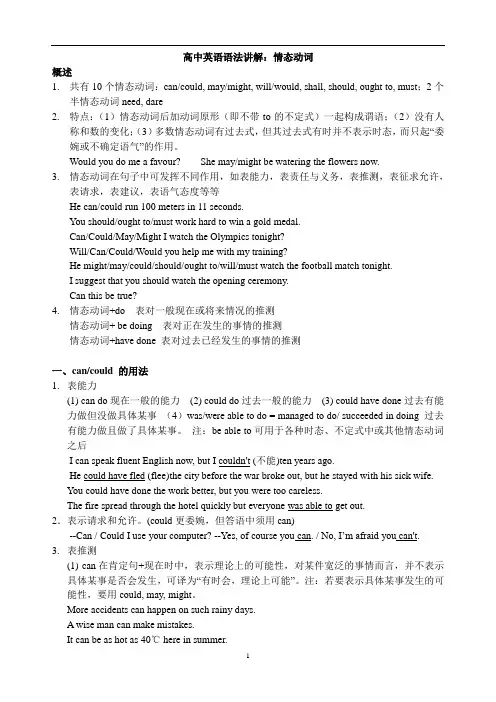
高中英语语法讲解:情态动词概述1.共有10个情态动词:can/could, may/might, will/would, shall, should, ought to, must;2个半情态动词need, dare2.特点:(1)情态动词后加动词原形(即不带to的不定式)一起构成谓语;(2)没有人称和数的变化;(3)多数情态动词有过去式,但其过去式有时并不表示时态,而只起“委婉或不确定语气”的作用。
Would you do me a favour? She may/might be watering the flowers now.3.情态动词在句子中可发挥不同作用,如表能力,表责任与义务,表推测,表征求允许,表请求,表建议,表语气态度等等He can/could run 100 meters in 11 seconds.You should/ought to/must work hard to win a gold medal.Can/Could/May/Might I watch the Olympics tonight?Will/Can/Could/Would you help me with my training?He might/may/could/should/ought to/will/must watch the football match tonight.I suggest that you should watch the opening ceremony.Can this be true?4.情态动词+do 表对一般现在或将来情况的推测情态动词+ be doing 表对正在发生的事情的推测情态动词+have done 表对过去已经发生的事情的推测一、can/could 的用法1.表能力(1) can do现在一般的能力(2) could do过去一般的能力(3) could have done过去有能力做但没做具体某事(4)was/were able to do = managed to do/ succeeded in doing 过去有能力做且做了具体某事。
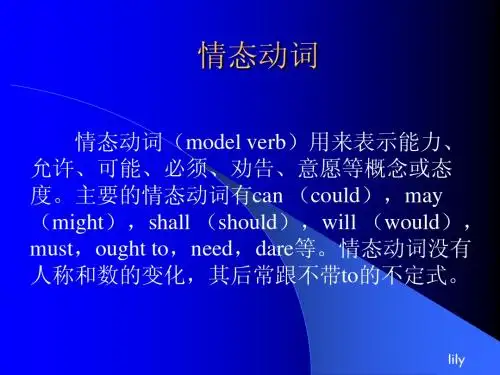
情态动词情态动词(model verb)用来表示能力、允许、可能、必须、劝告、意愿等概念或态度。
主要的情态动词有can (could),may (might),shall (should),will (would),must,ought to,need,dare等。
情态动词没有人称和数的变化,其后常跟不带to的不定式。
1. 情态动词的一般用法:●(1)表示能力:can,could,be able to●He is over80but stillcan read withoutPREPOSITION glasses.●She couldn't comeyesterday.●He can’t cometomorrow.(2)表示许可:can/could, may/might; can’t, maynot, mustn’t, must not●1)征询“许可”或给予“许可”可用can/could或may/might表示。
May用于正式场合,can用于非正式场合,could用于客气的询问,might极少用。
●You can go at four o’clock.●Could I borrow your pen?●Students may take3books each.●Might I ask whether you are using the typewriter?●2)表示“不允许”用can’t,may not,mustn’t;must not语气重。
●You can’t leave the table unless you finish your meal.●Put that cigarette out.You must not smoke near a petrol pump!●3)表示过去“许可”不用could,might,要用其他表达方式。
●We had been/were given permission to speak to the patient.●但在间接引语中表达过去“许可”,可用could,might。
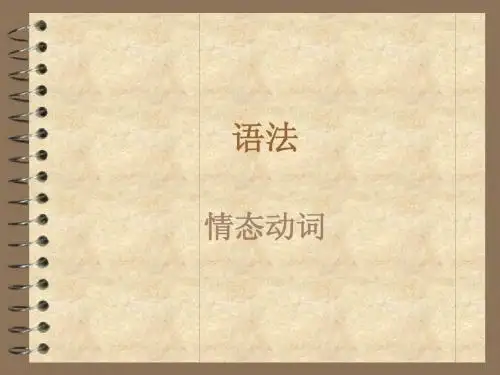
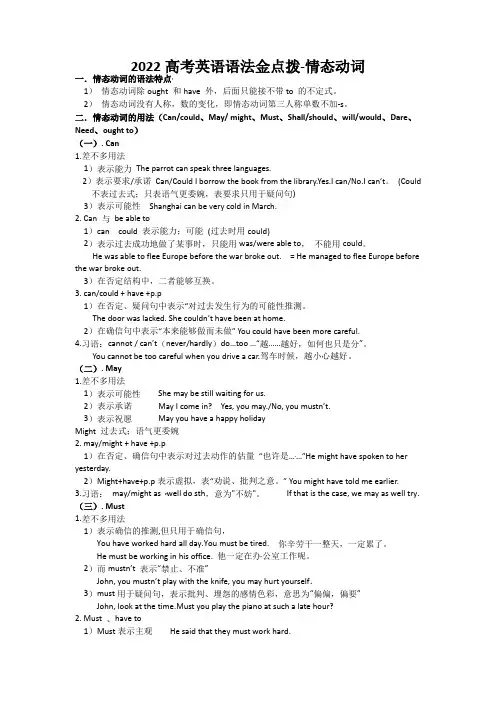
2022高考英语语法金点拨-情态动词一.情态动词的语法特点1)情态动词除ought 和have 外,后面只能接不带to 的不定式。
2)情态动词没有人称,数的变化,即情态动词第三人称单数不加-s。
二.情态动词的用法(Can/could、May/ might、Must、Shall/should、will/would、Dare、Need、ought to)(一). Can1.差不多用法1)表示能力The parrot can speak three languages.2)表示要求/承诺Can/Could I borrow the book from the library.Yes.I can/No.I can’t。
(Could 不表过去式;只表语气更委婉,表要求只用于疑问句)3)表示可能性Shanghai can be very cold in March.2. Can 与be able to1)can could 表示能力;可能(过去时用could)2)表示过去成功地做了某事时,只能用was/were able to,不能用could。
He was able to flee Europe before the war broke out.= He managed to flee Europe before the war broke out.3)在否定结构中,二者能够互换。
3. can/could + have +p.p1)在否定、疑问句中表示“对过去发生行为的可能性推测。
The door was lacked. She couldn’t have been at home.2)在确信句中表示“本来能够做而未做” You could have been more careful.4.习语:cannot / can’t(never/hardly)do…too …“越……越好,如何也只是分”。
You cannot be too careful when you drive a car.驾车时候,越小心越好。
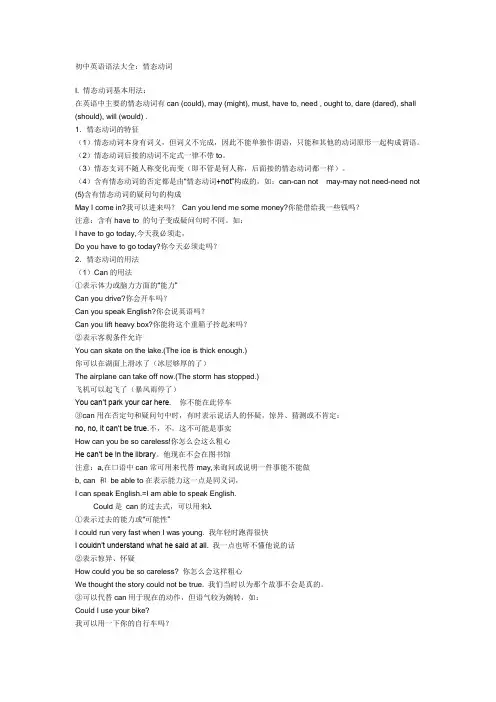
初中英语语法大全:情态动词I. 情态动词基本用法:在英语中主要的情态动词有can (could), may (might), must, have to, need , ought to, dare (dared), shall (should), will (would) .1.情态动词的特征(1)情态动词本身有词义,但词义不完成,因此不能单独作谓语,只能和其他的动词原形一起构成谓语。
(2)情态动词后接的动词不定式一律不带to。
(3)情态支词不随人称变化而变(即不管是何人称,后面接的情态动词都一样)。
(4)含有情态动词的否定都是由“情态动词+not”构成的,如:can-can not may-may not need-need not (5)含有情态动词的疑问句的构成May I come in?我可以进来吗?Can you lend me some money?你能借给我一些钱吗?注意:含有have to 的句子变成疑问句时不同。
如:I have to go today,今天我必须走,Do you have to go today?你今天必须走吗?2.情态动词的用法(1)Can的用法①表示体力或脑力方面的“能力”Can you drive?你会开车吗?Can you speak English?你会说英语吗?Can you lift heavy box?你能将这个重箱子拎起来吗?②表示客观条件允许You can skate on the lake.(The ice is thick enough.)你可以在湖面上滑冰了(冰层够厚的了)The airplane can take off now.(The storm has stopped.)飞机可以起飞了(暴风雨停了)You can’t park your car here.你不能在此停车③can用在否定句和疑问句中时,有时表示说话人的怀疑,惊异、猜测或不肯定:no, no, it can’t be true.不,不,这不可能是事实How can you be so careless!你怎么会这么粗心He can’t be in the library。
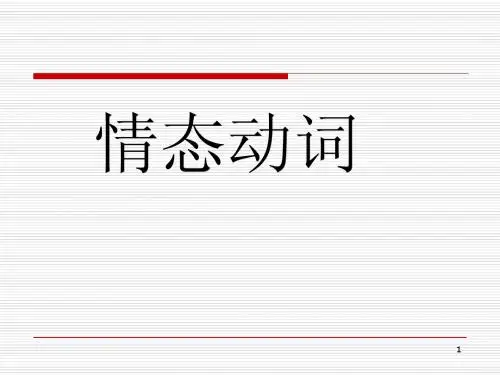
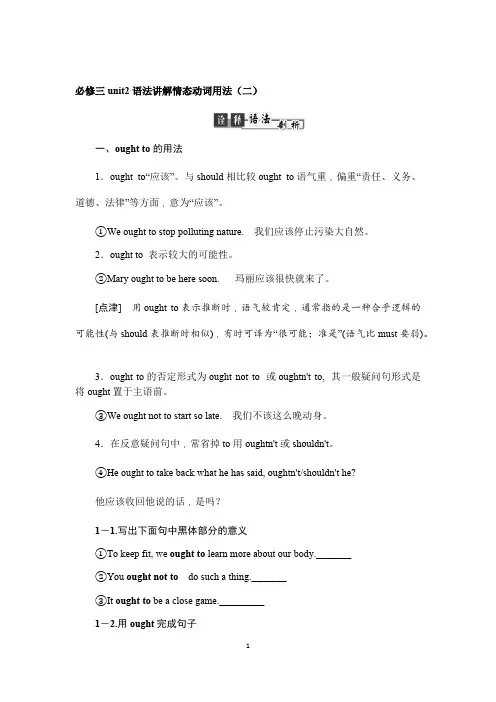
必修三unit2语法讲解情态动词用法(二)一、ought to的用法1.ought to“应该”。
与should相比较ought to语气重,偏重“责任、义务、道德、法律”等方面,意为“应该”。
①We ought to stop polluting nature. 我们应该停止污染大自然。
2.ought to 表示较大的可能性。
②Mary ought to be here soon. 玛丽应该很快就来了。
[点津] 用ought to表示推断时,语气较肯定,通常指的是一种合乎逻辑的可能性(与should表推断时相似),有时可译为“很可能;准是”(语气比must要弱)。
3.ought to的否定形式为ought not to 或oughtn't to, 其一般疑问句形式是将ought置于主语前。
③We ought not to start so late. 我们不该这么晚动身。
4.在反意疑问句中,常省掉to用oughtn't或shouldn't。
④He ought to take back what he has said, oughtn't/shouldn't he?他应该收回他说的话,是吗?1-1.写出下面句中黑体部分的意义①To keep fit, we ought to learn more about our body._______②You ought not to do such a thing._______③It ought to be a close game._________1-2.用ought完成句子④你不该责备他。
You ____________(scold )him.⑤我明天该动身吗?—______________(_leave )tomorrow?是的,你应该。
—Yes, you_ought_to.⑥我们现在应该走,是吗?We ought to go now, ____________?二、have to, don't have to与mustn't的用法1.have to(口语中常用have got to)表示客观需要做的事情,意为“必须;不得不”。
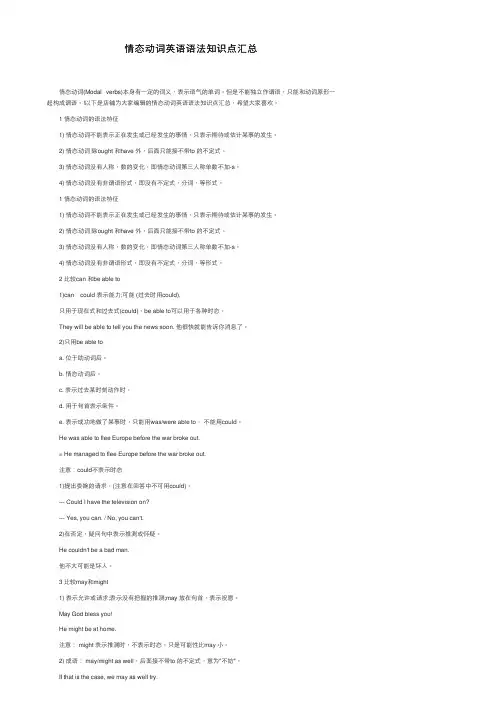
情态动词英语语法知识点汇总情态动词(Modal verbs)本⾝有⼀定的词义,表⽰语⽓的单词。
但是不能独⽴作谓语,只能和动词原形⼀起构成谓语。
!以下是店铺为⼤家编辑的情态动词英语语法知识点汇总,希望⼤家喜欢。
1 情态动词的语法特征1) 情态动词不能表⽰正在发⽣或已经发⽣的事情,只表⽰期待或估计某事的发⽣。
2) 情态动词除ought 和have 外,后⾯只能接不带to 的不定式。
3) 情态动词没有⼈称,数的变化,即情态动词第三⼈称单数不加-s。
4) 情态动词没有⾮谓语形式,即没有不定式,分词,等形式。
1 情态动词的语法特征1) 情态动词不能表⽰正在发⽣或已经发⽣的事情,只表⽰期待或估计某事的发⽣。
2) 情态动词除ought 和have 外,后⾯只能接不带to 的不定式。
3) 情态动词没有⼈称,数的变化,即情态动词第三⼈称单数不加-s。
4) 情态动词没有⾮谓语形式,即没有不定式,分词,等形式。
2 ⽐较can 和be able to1)can could 表⽰能⼒;可能 (过去时⽤could),只⽤于现在式和过去式(could)。
be able to可以⽤于各种时态。
They will be able to tell you the news soon. 他很快就能告诉你消息了。
2)只⽤be able toa. 位于助动词后。
b. 情态动词后。
c. 表⽰过去某时刻动作时。
d. ⽤于句⾸表⽰条件。
e. 表⽰成功地做了某事时,只能⽤was/were able to,不能⽤could。
He was able to flee Europe before the war broke out.= He managed to flee Europe before the war broke out.注意:could不表⽰时态1)提出委婉的请求,(注意在回答中不可⽤could)。
--- Could I have the television on?--- Yes, you can. / No, you can't.2)在否定,疑问句中表⽰推测或怀疑。

情态动词常见的情态动词有:can 能may 可以will,would (表意愿)need 需要dare 敢must 必须have to 不得不shall,should 应该(表义务)ought to 应该1.can,could 的用法1.1表能力,有“能”、“会”、“能够”的意思例如:Can you drive a car? 你会开车吗?-----Yes, I can. 我会。
-----No, I can't. 我不会。
1.2表允许,在口语中代替may,有“可以”的意思例如:Can I use your bike?我可以用你的自行车吗?1.3表示可能性,常用于否定句和疑问句例如:Can it be true?那会是真的吗?Today is Sunday. He can't be at school.今天是星期天。
他不可能在学校里。
1.4过去式could表示的语气更加委婉、客气例如:Could I come to see you tomorrow?明天我可以来见你吗?1.5 can 和be able to 的比较1) can 只有一般现在时和一般过去时两种时态(could),其他时态要用be able to的形式例如:I haven't been able to get in touch with her.我一直没能和她联系上。
2) 通常can 和be able to 可以互换例如:He will come if he can.如果可能的话,他一定会来。
2.may,might的用法2.1表示许可或征求对方的许可,有“可以”的意思。
例如:You may go now.你可以走了。
May I use your computer?我用一下你的电脑可以吗?2.2回答以may开头的疑问句有如下表达法:例如:May I smoke here? 我可以在这儿抽烟吗?-----Yes, you may.-----Yes, please.------No, you can't.------No, you mustn't.------No, you'd better not.2.3表示猜测,通常只用于陈述句例如:You may be right.你可能是对的。
语法- 情态动词情态动词表示说话人的能力、义务、必要、猜测等语气或情感。
情态动词必须和动词原形一起构成谓语,无人称和数的变化。
其使用要点如下:一、情态动词考点解析can, could和be able to的用法1.can和could表示“能,会”,有一般现在时和一般过去时两种时态,在将来时和完成时中必须用be able to。
表“能力”时can与be able to换用。
例如:Can you type? =Are you able to type?We’ll be able to get you a job soon.(在将来时中不可用can)He has been able to finish the work on time.(在完成时中不可用can)2.“can/could+ have done”表“本能够做某事而没有做”。
例如:You could have been more careful.你本能够更细心的。
3.“can’t/couldn’t+ have done”表“不可能做了某事”。
例如:Without your help, I can’t have mad e such great progress.没有你的帮助,我不可能取得这么大的进步。
must和have to的用法1.must和have to都表示“必须,不得不”。
must强调主观性;have to强调客观需要。
must只用于一般现在时,而have to有更多的时态形式。
例如:I must learn another language.(主观想法:我想要)I have to learn another language.(客观需要:我不得不)It’ll have to be finishe d in two days.(have to用于将来时中)He has had to reconsider his position.(have to用于现在完成时)2.两者的否定意义不同:mustn’t表示“禁止;不可以”,而don’t have to 表示“不必”,意思相当needn’t。
情态动词1、表示许可的can / could / may / might / mustcan / could / may / might均可表示许可,只不过may较侧重讲话人的许可,而can较侧重客观情况的许可;could / might的语气比can / may更委婉、客气;在答语中表示允许别人做某事要can / may,不能用 could / might。
如:例1.— Could [Can, May, Might] I use it?— Yes, you can [may]. 可以。
(不用 could / might)must表示必须作某事,其否定式mustn’t表示“不可以”。
例2.We must not speak of it again.2、had better的用法注意否定式、疑问式及其回答。
如:例3.You’d better not go there.例4.He’d better go with us, hadn’t he?例5.What had we better do?例6.Had we better not go?作情态动词:通常用在疑问句、否定句中,或与条件句、whether, hardly, nobody等连用。
如:例7.Need he go so soon?例8.He needn’t go.例9.If she wants anything, she need only ask.注意:(1). 因 need 不能用于肯定句,因此肯定回答要用 must。
—Need I stay here any longer?—No, you needn’t.—Yes, you must.(2). need have done 的否定式或疑问式,表示“本来不必做某事,但事实上却做了”。
例10.She needn’t have come in person a call wou ld have been enough.。
第四章情态动词(一)情态动词表示说话人对动作或状态的各种观点和态度,如需要、猜测、意愿或怀疑等。
情态动词有词义,但不完全,是所谓的“辅助性”动词,在句中不能单独充当谓语。
一、情态动词的特征和形式A. 情态动词的各种形式见下表:情态动词maymightcancouldmusthave toought towillwouldshallshouldneeddareused to否定式may notmight notcannot/can notcould notmust notdo not have toought not towill notwould notshall notshould notneed notdare notused not todid not use to简略否定式mayn't(老式英语,现在不常见)mightn'tcan'tcouldn'tmustn'tdon't have tooughtn't to (否定句中to可省略)won'twouldn'tshan't (只用于英国英语)shouldn'tneedn'tdaren'tusedn't todidn't use toB.情态动词除ought to, used to等外,后面只接不带to的不定式。
1.情态动词+doYou shouldn't be so careless. 你不该这样粗心大意。
Jessica told him yesterday she might not go on the trip.杰西卡昨天告诉他,她可能不去旅行了。
Difficulties can and must be overcome.困难能够而且必须克服。
2.情态动词+be doingShe must be listening to pop music.她肯定在听流行音乐。
语法详解情态动词的疑问句形式情态动词(Modal Verbs)在英语语法中起着非常重要的作用。
它们不仅能够表示说话人的情感、态度和意愿,还可以用来构成疑问句。
本文将详细讨论情态动词在疑问句形式中的用法,以帮助读者更好地理解和应用。
一、基本用法情态动词有can、could、may、might、will、would、shall、should、must等。
在构成疑问句时,它们通常直接放在主语之前。
例如:- Can you help me?(你能帮助我吗?)- Should we go now?(我们现在应该走吗?)- Might she be home?(她可能在家吗?)二、特殊疑问句特殊疑问句是以疑问词(如what、where、when、why、how等)开头的疑问句。
在特殊疑问句中,情态动词仍然位于主语之前,而疑问词则位于情态动词和动词之间。
例如:- What can I do for you?(我能为你做什么?)- How should we handle this situation?(我们应该如何处理这种情况?)- Why must he apologize?(他为什么必须道歉?)三、倒装疑问句倒装疑问句是在陈述句后面加上一个相反意义的疑问句,用于征求对方的确认或否认意见。
在倒装疑问句中,情态动词与主语倒装,即将情态动词放在主语之前。
例如:- You can swim, can't you?(你会游泳,对吗?)- He should eat more, shouldn't he?(他应该多吃一些,不是吗?)- They will come, won't they?(他们会来,是吧?)四、命令和建议有时候,疑问句形式的情态动词可以用来表达命令或建议,并带有一定的语气。
例如:- Could you please pass me the salt?(你能给我递一下盐吗?)- Might I suggest a different approach?(我可以建议采取不同的方法吗?)- Shouldn't you go to bed early?(你不应该早点睡觉吗?)五、多重情态动词有时候,一个句子中会出现多个情态动词。
初中英语情态动词用法详解【情态动词知识梳理】情态动词有具体的词义,但也同助动词一样,需要与其他词语一起构成句子的谓语,另外情态动词没有人称和数的变化,情态动词后必须跟动词原形。
考点一:can,may,must等情态动词在陈述句中的用法:1. can的用法:(1).表示能力、许可、可能性。
表示能力时一般译为“能、会”,即有种能力,尤其是生来具备的能力,此时may和must均不可代替它。
如:She can swim fast, but I can’t . 她能游得很快,但我不能。
I can see with my eyes.我用眼睛看。
(2).表示许可,常在口语中。
如:You can use my dictionary. 你可以用我的字典。
(3).表示推测,意为“可能”,常用于否定句和疑问句中,此时can’t译为“不可能”。
如:Can the news be true?这个消息会是真的吗?—Can it be our teacher?那个人有可能是我们老师吗?—No, it can’t be our teacher. He is on a visit to the Great Wal l.不可能。
咱们老师正在游览长城呢。
【例题】—I think Miss Gao must be in the library. She said she would go there.—No. She __be there, I have just been there.【解析】根据下文“我刚去过那儿”可知,应为“不可能”,can’t表示推测[答案]2. could的用法:(1).can的过去式,意为“能、会”,表示过去的能力。
如:He could write poems when he was 10. 他十岁时就会写诗。
(2). could在疑问句中,表示委婉的语气,此时could没有过去式的意思。
如:Could you do me 你能帮我个忙吗?—Could I use your pen?我能用一下你的钢笔吗?—Yes, you can.可以。
(注意回答)3. may的用法:(1).表示请求、许可,比can正式,如:May I borrow your bike?我可以借你的自行车吗?You may go home now.现在你可以回家了。
【例题】—_______ I borrow your MP3?—Sure . Here you are. A. May B.Should C.Must D.Would【解析】在此处表示请求,意为“做……可以吗”。
答案:A(2) .表示推测,谈论可能性,意为“可能,或许”,一般用于肯定句中。
如:It may rain tomorrow .明天可能会下雨。
She may be at home.她可能在家呢.(3) .may的过去式为might,表示推测时。
可能性低于may。
如:He is away from school. He might be sick.他离开学校了,可能是他生病了。
(4) . 表示希望、祈求、祝愿,常可译为“祝愿”。
通常是用may +主+V例如:May you havea good time.祝你过得愉快。
May you be happy!祝你幸福!May you succeed!祝你成功!4. must的用法:(1).must表示主观看法,意为“必须、一定”。
如:You must stay here until I come back.在我回来之前你必须呆在这儿。
Must I hand in my homework right now?我必须现在交作业吗?(2)对must引导的疑问句,肯定回答为must,否定回答或don’t have to .如:—Must I finish my homework?我现在必须完成作业吗(4)must表示有把握的推测,用于肯定句。
如: The light is on, so he must be at home now.灯亮着,他现在肯定在家。
注意其反意问句的构成形式:当must表示肯定的判断、推测时,其反意疑问句要用实际问句的助动词来构成。
如:She must have seen the film before?(注意反意疑问句的后半部分)You must have met uncle Wang in the shop (注意反意疑问句的后半部分)5. need的用法:(1).need表示需要、必须,主要用于否定句和疑问句中,,意为“没有必要,不必”。
用need 提问时,肯定回答don’t have to。
如:—Need I stay here any longer? 我还有必要留在这儿吗?—Yes, you must .是的。
—No. you /don’t have to.不,你不必。
(2).need还可以作实义动词,此时有人称、数和时态的变化,如果是人作主语后边多接动词不定式。
如:I need to do it right now.我需要马上做这件事。
He needs to learn more about the girl.他需要多了解那个女孩。
如果是物作主语,一般用need doing与need to be done这种情况下应注意两点:①.主动形式的动名词doing具有被动的含义;②.该动名词可以改为其动词不定式的被动形式而句子的意义不变。
例如:. The door needs painting. = The door needs to be painted.那扇门需要油漆一下。
Your car needs mending. = Your car needs to be repaired.你的车需要维修了。
7. shall的用法:shall表示征求对方意见(多用于第一、三人称),如:Shall we go out for a walk?我们出去散步好吗?在英语中,我们可以用其他多种方式提出我们的建议或征求对方意见。
(1).用“Let's do...”来提出建议。
如:Let's go for a walk after supper.(2).用“What/How about...?”来提出建议;about后接名词或动词ing形式。
如:What about/How about a drink? What about/How about taking Tom with us?(3).用“Why not...?”来提出建议,表示“何不……”not面后接动词原形。
“Why not...?”实际上是“Why don't you/we...?”的简略形式。
如:Why not meet at the school gate at eight? Why don't we stay here another day?(4).用“Would you like...?”来提出建议,意思是“你想要……吗?”Would you like后可接名词或不定式。
如:Would you like a cup of tea?Would you like to go and see her?因此,如果我们说:“去游泳好吗?”英语中可有这样几种表达法:Shall we go for a swim? Let's go for a swim,shall we?What about/How about going swimming?Why not go for a swim?Would you like to go for a swim?What do you think of going for a swim?8. should的用法:(1).should意为“应该”,可表示劝告、建议、义务、责任等。
如:We should protect the environment.我们应该保护环境。
(2)Should have done表示对过去动作的责备、批评。
如:You should have finished your homework.你应该已经完成作业了。
(事实上你没有完成。
)9. will的用法:will表示意愿、意志、打算,可用于多种人称。
如:I will help you if I’m free this afternoon.今天下午如果我有空,我就会帮你。
注意:1、will在there be句型中的形式及其句式变换。
由于“一般将来时”的结构可以用“will+动词原形”来表示,所以there be句型的一般将来时的形式就是there will be。
(一定不能说there will have)例如:There are many students in our school.→There will be many students in our school. There will be a sports meeting next week.一定不能说:There will have a sports meeting next week.2、will与be going to do something区别:①. be going to表示近期、眼下就要发生的事情,will表示的将来时间则较远一些,如:He is going to write a letter tonight. He will write a book one day.②. be going to表示根据主观判断将来肯定发生的事情,will表示客观上将来势必发生的事情。
He is seriously ill. He is going to die. He will be twenty years old.③. be going to含有“计划,准备”的意思,而will则没有这个意思,如:She is going to lend us her book.He will be here in half an hour.④.在有条件从句的主句中,一般不用be going to,而多用will,如:If any beasts comes at you, I'll stay with you and help you.10. had better的用法:had better意为“最好”,没有人称的变化,后面接不带to的不定式,其否定形式为:had better not。
如:We had better go now.我们最好现在就走。
You had better not give the book to him.你最好不要把这本书给他。